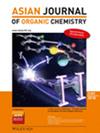异相化三苯基膦-钯催化剂催化丙烯支化甲氧羰基化反应
IF 2.7
4区 化学
Q1 CHEMISTRY, ORGANIC
引用次数: 0
摘要
丙烯的支链选择性羰基化是学术界和工业界都面临的一个众所周知的挑战。在这项研究中,我们报道了利用易于异质化的三苯基膦-钯催化剂(Pd/3V-PPh3@POP),氯化锂促进丙烯的支链选择性甲氧基羰基化反应。测试了各种(异相)配体、添加剂、酸和催化金属。在其他条件相同的情况下,与不添加LiCl相比,Pd/3V-PPh3@POP催化剂的支链选择性提高了36.9%(支链选择性71.4%对34.5%,周转率124.5对421.8)。采用x射线衍射(XRD)、高角环状暗场扫描透射电镜(HAADF-STEM)、扫描电镜能谱仪(SEM-EDS)、Brunner-Emmet-Teller (BET)、热重分析(TGA)等实验对优选催化剂Pd/3V-PPh3@POP进行了表征,并在连续搅拌反应器的简单过滤回收实验中进行了进一步的测试。本文章由计算机程序翻译,如有差异,请以英文原文为准。

LiCl‐Promoted Branched Methoxycarbonylation of Propylene Using a Heterogenized Triphenylphosphine‐palladium Catalyst
Branched selective carbonylation of propylene is a well‐known challenge for both academia and industry. In this study, we reported LiCl‐promoted branched selective methoxycarbonylation of propylene utilizing an easy heterogenized triphenylphosphine‐palladium catalyst (Pd/3V‐PPh3@POP). Various (heterogenized) ligands, additives, acids, and catalytic metals were tested. The catalyst Pd/3V‐PPh3@POP in the presence of LiCl gave a 36.9% increased branched selectivity at the expense of activity compared to the absence of additives (71.4% versus 34.5% branched selectivity, turnover numbers of 124.5 versus 421.8) under otherwise identical conditions. The optimal catalyst Pd/3V‐PPh3@POP was characterized using X‐ray diffraction (XRD), high‐angle annular dark field scanning transmission electron microscopy (HAADF‐STEM), scanning electron microscopy energy dispersive spectrometer (SEM‐EDS), Brunner–Emmet–Teller (BET), and thermogravimetric analysis (TGA) experiments and further tested in simple filtration recycling experiments using a continuous stirring reactor.
求助全文
通过发布文献求助,成功后即可免费获取论文全文。
去求助
来源期刊

Asian Journal of Organic Chemistry
CHEMISTRY, ORGANIC-
CiteScore
4.70
自引率
3.70%
发文量
372
期刊介绍:
Organic chemistry is the fundamental science that stands at the heart of chemistry, biology, and materials science. Research in these areas is vigorous and truly international, with three major regions making almost equal contributions: America, Europe and Asia. Asia now has its own top international organic chemistry journal—the Asian Journal of Organic Chemistry (AsianJOC)
The AsianJOC is designed to be a top-ranked international research journal and publishes primary research as well as critical secondary information from authors across the world. The journal covers organic chemistry in its entirety. Authors and readers come from academia, the chemical industry, and government laboratories.
 求助内容:
求助内容: 应助结果提醒方式:
应助结果提醒方式:


